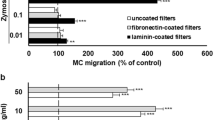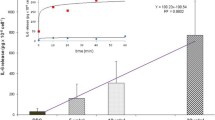Abstract
The ability to respond metabolically to stimulation with both soluble and paniculate substances was investigated in human polymorphonuclear leukocytes (PMNLs) isolated from an aseptic inflammatory reaction. Exudate PMNLs isolated from skin chambers (E-PMNLs) and blood PMNLs isolated from the peripheral blood (B-PMNLs) of the same individual were investigated in parallel. E-PMNLs were primed, resulting in an increased chemiluminescence (CL) response to subsequent stimulation with the chemotactic peptide formyl-methionyl-leucyl-phenylalanine (FMLP) (334%) and serum-opsonized yeast particles (C3 yeast) (201%), as compared to B-PMNLs. Phorbol myristate acetate (PMA) on the other hand, induced a CL response in E-PMNLs that was only 70% of the response obtained in B-PMNLs. A similar primed state resulting in enhancement of the CL response to FMLP and C3 yeast could be induced in B-PMNLs by pretreatment with a bacterial culture filtrate. Pretreatment of E-PMNLs with the bacterial culture filtrate, however, did not increase the CL response to FMLPs any further. The enhanced functional response to FMLPs in E-PMNLs was accompanied by an increased binding of the peptide, demonstrated by a doubling of the amount of bound f-Met-Leu-[3H]Phe (209%), as compared to B-PMNLs. The increased C3-yeast-induced CL generation in E-PMNLs was accompanied by an increased ingestion and attachment of C3-opsonized yeast particles. The enhancement of phagocytosis in E-PMNLs was, however, dependent upon the opsonin used, since IgG-opsonized yeast particles were phagocytosed to the same extent by E-PMNLs and B-PMNLs, thereby indicating that selective receptor modulation is also involved in the priming of E-PMNLs for an enhanced response to C3-yeast. These results show that exudate cells isolated from skin chambers are modulated with respect to receptor-mediated functions resulting in an increased metabolic response to FMLP coupled with an increased binding of the peptide and an increased phagocytosis of C3-coated yeast particles. Receptor modulation during exudation may be an important mechanism in regulating the inflammatory response by PMNLs.
Similar content being viewed by others
References
Klebanoff, S. J., andR. A. Clark. 1978. The neutrophil: Function and Clinical Disorders. Elsevier/North-Holland Biomedical Press, Amsterdam.
Babior, B. M. 1984. The respiratory burst of phagocytes.J. Clin. Invest. 73:599.
Becker, E. L., H. J. Showell, P. M. Henson, andL. S. Hsu. 1974. The ability of chemotactic factors to induce lysosomal enzyme release. I. The characteristics of the release, the importance of surface and the relation of enzyme release to chemotactic responsiveness.J. Immunol. 112:2047.
Hed, J. 1981. Response of polymorphonuclear leukocytes to particles opsonized with IgG or C3b.Monogr. Allergy 17:92.
Wilkinson, P. C. 1982. Chemotaxis and Inflammation, 2nd ed. Churchill-Livingstone, Edinburgh.
Huey, R., andT. E. Hugli. 1985. Characterization of a C5a receptor on human polymorphonuclear leukocytes (PMN).J. Immunol. 135:2063.
Allen, R. A., A. J. Jesaitis, L. A. Sklar, C. G. Cochrane, andR. G. Painter. 1986. Physiochemical properties of theN-formyl peptide receptor on human neutrophils.J. Biol. Chem. 26:1854.
Goldman, D. W., andE. J. Goetzl. 1982. Specific binding of leukotriene B4 to receptors on human polymorphonuclear leukocytes.J. Immunol. 129:1600.
O'Flaherty, J. T., J. R. Surles, J. Redman, D. Jacobson, C. Piantadosi, andR. L. Wykle. 1986. Binding and metabolism of platelet-activating factor by human neutrophils.J. Clin. Invest. 78:381.
Berger, M., J. O'Shea, A. S. Cross, T. M. Folks, T. M. Chused, E. J. Brown, andM. M. Frank. 1984. Human neutrophils increase expression of C3bi as well as C3b receptors upon activation.J. Clin. Invest. 74:1566.
Fearon, D. T. 1980. Identification of the membrane glycoprotein that is the C3b receptor of the human erythrocyte, polymorphonuclear leukocyte, B lymphocyte, and monocyte.J. Exp. Med. 152:20.
Fleit, H. B., S. D. Wright, andJ. C. Unkeless. 1982. Human neutrophil Fc-gamma receptor distribution and structure.Proc. Natl. Acad. Sci. U.S.A. 79:3275.
Ginsburg, I., andP. Q. Quie. 1980. Modulation of human polymorphonuclear leukocyte chemotaxis by leukocyte extracts, bacterial products, inflammatory exudates, and polyelectrolytes.Inflammation 4:301.
Freischlag, J. B. Backstrom, D. Kelly, G. Keehn, andR. W. Busuttil. 1986. Comparison of blood and peritoneal neutrophil activity in rabbits with and without peritonitis.J. Surg. Res. 40:145.
Perianin, A., M. Roch-Arveller, J.-P. Giroud, andJ. Hakim. 1985. Effect of acute non-immune inflammation on locomotion of exudate and blood rabbit neutrophils.Inflammation 9:389.
Thomsen, P., L. M. Bjursten, andL. E. Ericson. 1986. Joint fluid leukocyte activation by preformed immune complexes.Inflammation 10:243.
Zimmerli, W., B. Seligmann, andJ. I. Gallin. 1986. Exudation primes human and guinea pig neutrophils for subsequent responsiveness to the chemotactic peptideN-formyl-methionyl-leucyl-phenylalanine and increases complement C3bi receptor expression.J. Clin. Invest. 77:925.
Fletcher, M. P., B. E. Seligmann, andJ. I. Gallin. 1982. Correlation of human neutrophil secretion, chemoattractant receptor mobilization, and enhanced functional capacity.J. Immunol. 128:941.
O'Shea, J. J., E. J. Brown, B. E. Seligmann, J. A. Metcalf, M. M. Frank, andJ. I. Gallin. 1985. Evidence for distinct intracellular pools of receptors for C3b and C3bi in human neutrophils.J. Immunol. 134:2580.
VanEpps, D. E., andM. L. Garcia. 1980. Enhancement of neutrophil function as a result of prior exposure to chemotactic factor.J. Clin. Invest. 66:167.
Briheim, G., O.Stendahl, and C.Dahlgren. 1987. The increased metabolic response by neutrophils isolated from patients with meningococcal meningitis can be simulated by an interaction in vitro between the phagocytes and meningococcal culture filtrate.J. Infect. Dis. (in press).
Briheim, G., O.Stendahl, and C.Dahlgren. 1987. In vitro modulation of human neutrophil function by a culture filtrate fromNeisseria meningitidis (submitted).
Hellum, K. B., andC. O. Solberg. 1977. Human leukocyte migration: Studies with an improved skin chamber technique.Acta Pathol. Microbiol. Scand. Sect. C. 85:413.
Scheja, A., andA. Forsgren. 1985. A skin chamber technique for leukocyte migration studies; description and reproducibility.Acta Pathol. Microbiol. Immunol. Scand. Sect. C. 93:25.
Boyum, A. 1968. Isolation of mononuclear cells and granulocytes from human blood. Isolation of mononuclear cell by one centrifugation and of granulocytes by combining centrifugation and sedimentation at 1g.Scand J. Clin. Lab. Invest. Suppl. 97:77.
Hed, J. 1977. The extinction of fluorescence by crystal violet and its use to differentiate between attached and ingested microorganisms in phagocytosis.FEMS Lett. 1:357.
Csato, M., A. Dobozy, L. Raith, andN. Simon. 1985. The function of polymorphonuclear leukocytes emigrating into the skin.Acta Derm.-Venereol. 65:106.
Wandall, J. H. 1982. Function of polymorphonuclear neutrophilic leucocytes. Comparison of leucocytes from blood and exudate in healthy volunteers.Acta Pathol. Microbiol. Immunol. Scand. Sect. C. 90:7.
Scheja, A., andA. Forsgren. 1985. Functional properties of polymorphonuclear leukocytes accumulated in a skin chamber.Acta Pathol. Microbiol. Immunol. Scand. Sect. C. 93:31.
Bentwood, B. J., andP. M. Henson. 1980. The sequential release of granule constituents from human neutrophils.J. Immunol. 124:855.
Nelson, R. D., R. T. McCormack, V. D. Fiegel, andR. L. Simmons. 1978. Chemotactic deactivation of human neutrophils: Evidence for nonspecific and specific components.Infect. Immun. 22:441.
Fletcher, M. P., andJ. I. Gallin. 1983. Human neutrophils contain an intracellular pool of putative receptors for the chemoattractantN-formyl-methionyl-leucyl-phenylalanine.Blood 62:792.
Gallin, J. I., M. P. Fletcher, B. E. Seligmann, S. Hoffstein, K. Cehrs, andN. Mounessa. 1982. Human neutrophil-specific granule deficiency: A model to assess the role of neutrophil-specific granules in the evolution of the inflammatory response.Blood 59:1317.
Gallin, J. I., J. A. Metcalf, D. Roos, B. E. Seligmann, andM. M. Friedman. 1984. Organelle-depleted human neutrophil cytoplasts used to study f-Met-Leu-Phe receptor modulation and cell function.J. Immunol. 133:415.
Gallin, J. I. 1984. Neutrophil specific granules: A fuse that ignites the inflammatory response.Clin. Res. 32:320.
Fletcher, M. P., andJ. I. Gallin. 1980. Degranulating stimuli increase the availability of receptors on human neutrophils for the chemoattractant f-Met-Leu-Phe.J. Immunol. 124:1585.
Fearon, D. T., andL. A. Collins. 1983. Increased expression of C3b receptors on polymorphonuclear leukocytes induced by chemotactic factors and by purification procedures.J. Immunol. 130:370.
Lee, J., R. M. Hakim, andD. T. Fearon. 1984. Increased expression of the C3b receptor by neutrophils and complement activation during haemodialysis.Clin. Exp. Immunol. 56:205.
Horan, T. D., D. English, andT. A. McPherson. 1982. Association of neutrophil chemiluminescence with microbicidal activity.Clin. Immun. Immunpathol. 22:259.
Sachs, T., C. F. Moldow, P. R. Craddock, T. K. Bowers, andH. S. Jacob. 1978. Oxygen radicals mediate endothelial cell damage by complement-stimulated granulocytes. An in vitro model of immune vascular damage.J. Clin. Invest. 61:1161.
Weiss, S. J., andA. F. LoBuglio. 1980. An oxygen-dependent mechanism of neutrophilmediated cytotoxicity.Blood 55:1020.
Author information
Authors and Affiliations
Rights and permissions
About this article
Cite this article
Briheim, G., Coble, B., Stendahl, O. et al. Exudate polymorphonuclear leukocytes isolated from skin chambers are primed for enhanced response to subsequent stimulation with chemoattractant f-Met-Leu-Phe and C3-opsonized yeast particles. Inflammation 12, 141–152 (1988). https://doi.org/10.1007/BF00916397
Issue Date:
DOI: https://doi.org/10.1007/BF00916397




